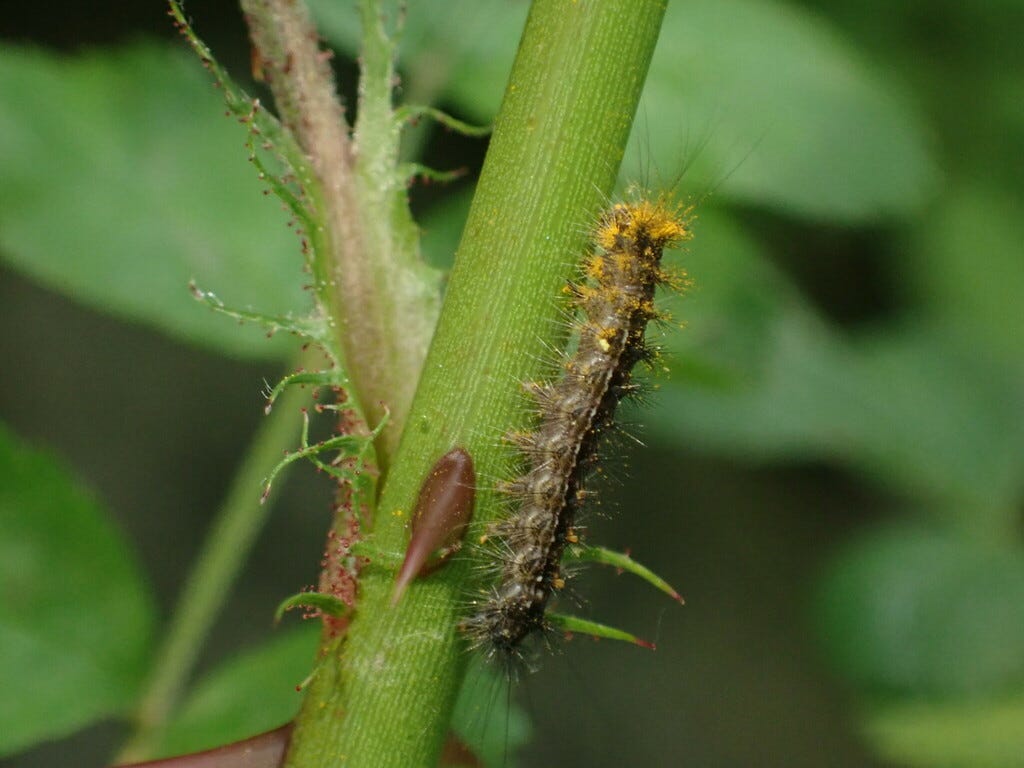Hey friends,
It’s been nice to see gregarious, gilled mushrooms pop up around the woods - we’ve got Platterful Mushrooms (Megacollybia rodmanii), Deer Mushrooms (Pluteus), and even some Chicken of the Woods (Laetiporus sulphureus) - but finding fungi this time of the year which I haven’t yet written about requires extra examination. That leads us to today’s fungus, the Multiflora Rose Rust - Phragmidium rosae-multiflorae, which I found on the preserve this past week. This plant pathogen native to eastern Asia has found a home on one of the nastiest invasive plants (Rosa multiflora) we have in the northeast.
Fun Facts
Rusts are an overlooked fungi this time of the year, but as a lot of the plant world springs to life so do the rusts. A few you may encounter are the spring beauty rust (Puccinia mariae-wilsoniae), mayapple rust (Allodus podophylli), and blackberry rust (Gymnoconia peckiana). Some rusts are autoecious (like multiflora rose rust) and only require one host, while others are heteroecious (like juniper-apple rust) and alternate hosts throughout their life cycle.
A lot of my job at the preserve involves the removal of invasive plants and multiflora rose is comfortably within the top three worst to remove. The “thorns” are recurved, like a fish hook, and will dig into whatever they catch. They’re usually white, but sometimes red, black, or green, and sometimes absent entirely. The shape is a key indicator because native roses have straight “thorns”. The plant forms impenetrable brambles the size of SUVs which is part of the reason it was brought to North America in the first place - to act as a living barrier for livestock.
A somewhat obnoxious fact that you can lord over your friends is that roses technically don’t have thorns (which is why I put thorns in quotes above). Instead, they have “prickles”. There are three sharp plant structures - thorns, spines, and prickles. Thorns are modified branches, spines are modified leafs, and prickles are “spine-like superficial outgrowths from the stem”. A thorn would be like what you find on a honeylocust (Gleditsia), a spine would be what you find on a cactus, and a prickle is the thorn-like structure of a rose. Every rose has its prickle?
Ecology
This fungus, like many other rusts, has specifically adapted to living on their host. Multiflora rose (Rosa multiflora) is originally from eastern Asia and was introduced to the US in the early 1800s for ornamental purposes. The rose quickly acclimated and now grows in disturbed areas - roadsides, forest edges, and fields - east and west of the Rockies. The plant flowers in June and the rust can be found on the plant in the spring.
Rust fungi are macrocyclic which means they have five different spore states: spermatia, aeciospores, urediniospores, teliospores, and basidiospores. That won’t be on the test, but it’s fun to try and wrap your mind around the different reproductive structures involved in just one organism’s life cycle. The general gist is that spermatia and the three subsequent spores are used for mating between rusts, while basidiospores are the spores that are sent out to find new hosts.
Upcoming Events
5/19: Adventure Day with Darien Land Trust. If you have young kids in Fairfield County I’ll have a fungal education table set up on Sunday. Learn more here: https://darienlandtrust.org/news/
6/7-6/9: Menla Retreat with Catskill Fungi. A fungal-filled weekend where we’ll make medicinal tinctures, kombucha, oyster mushroom grow-kits, and expand our mycelial minds.
6/15: Mushroom cultivation workshop at Peekskill Regeneration Farm. We’ll be introducing wine cap mushrooms to the farm and building grow-your-own mushroom kits. Learn more.
8/2-8/4: Mycofest. One of my favorite weekends of the year. I’ll be presenting on ecological restoration this year, too.
8/24: Mushroom Mania festival at the Adirondack Experience. I’ll be leading a couple walks at this mushroom festival with other, much more highly regarded mycologists, in the Adirondacks.
We’re going to do another NYMS walk at Manitou, I believe on 7/28, and we’re gonna do a walk in the Ramble in Central Park sometime in June so stay tuned. Lots of fun(gal) activities on the way,
Aubrey
References:
Kaishian P, Davis D, Moorman GW, Aime MC. Phragmidium rosae-multiflorae on Rosa multiflora reported from Pennsylvania, USA. Plant Dis. 2022 Jun 30. doi: 10.1094/PDIS-05-22-1073-PDN. Epub ahead of print. PMID: 35771108.










My brother, keep up the good work you do, I always learn something new from you,stay strong and positive peace your brother Sergio NYC